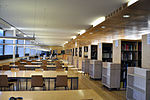Glòries station
1951 establishments in SpainBarcelona Metro line 1 stationsBarcelona Metro stubsCatalan railway station stubsRailway stations opened in 1951 ... and 3 more
Trambesòs stopsTransport in Sant Martí (district)Vague or ambiguous time from November 2018

Glòries is a station in the Barcelona Metro network, at the boundary between the Eixample and Sant Martí districts of Barcelona. It is served by TMB line L1. The station is named after the nearby Plaça de les Glòries Catalanes. It was opened in 1951, when Line 1 was extended from Marina to Clot. It can be accessed from Carrer d'Àlaba and Glòries. It is currently being adapted for disabled people. It will be connected to a future train station in the square, which will include access to L8. It is also an important tram station, being the terminus of Trambesòs tram routes T4 and T5.
Excerpt from the Wikipedia article Glòries station (License: CC BY-SA 3.0, Authors, Images).Glòries station
Túnel Glòries, Barcelona
Geographical coordinates (GPS) Address Nearby Places Show on map
Geographical coordinates (GPS)
| Latitude | Longitude |
|---|---|
| N 41.403333333333 ° | E 2.1869444444444 ° |
Address
Túnel Glòries
Túnel Glòries
08001 Barcelona (Sant Martí)
Catalonia, Spain
Open on Google Maps











